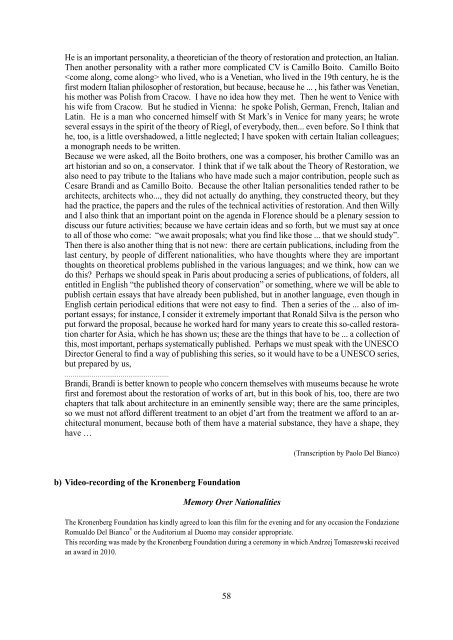Anfiteatro Andrzej Tomaszewski - Auditorium al Duomo Florence
Anfiteatro Andrzej Tomaszewski - Auditorium al Duomo Florence
Anfiteatro Andrzej Tomaszewski - Auditorium al Duomo Florence
Create successful ePaper yourself
Turn your PDF publications into a flip-book with our unique Google optimized e-Paper software.
He is an important person<strong>al</strong>ity, a theoretician of the theory of restoration and protection, an It<strong>al</strong>ian.<br />
Then another person<strong>al</strong>ity with a rather more complicated CV is Camillo Boito. Camillo Boito<br />
who lived, who is a Venetian, who lived in the 19th century, he is the<br />
first modern It<strong>al</strong>ian philosopher of restoration, but because, because he ... , his father was Venetian,<br />
his mother was Polish from Cracow. I have no idea how they met. Then he went to Venice with<br />
his wife from Cracow. But he studied in Vienna: he spoke Polish, German, French, It<strong>al</strong>ian and<br />
Latin. He is a man who concerned himself with St Mark’s in Venice for many years; he wrote<br />
sever<strong>al</strong> essays in the spirit of the theory of Riegl, of everybody, then... even before. So I think that<br />
he, too, is a little overshadowed, a little neglected; I have spoken with certain It<strong>al</strong>ian colleagues;<br />
a monograph needs to be written.<br />
Because we were asked, <strong>al</strong>l the Boito brothers, one was a composer, his brother Camillo was an<br />
art historian and so on, a conservator. I think that if we t<strong>al</strong>k about the Theory of Restoration, we<br />
<strong>al</strong>so need to pay tribute to the It<strong>al</strong>ians who have made such a major contribution, people such as<br />
Cesare Brandi and as Camillo Boito. Because the other It<strong>al</strong>ian person<strong>al</strong>ities tended rather to be<br />
architects, architects who..., they did not actu<strong>al</strong>ly do anything, they constructed theory, but they<br />
had the practice, the papers and the rules of the technic<strong>al</strong> activities of restoration. And then Willy<br />
and I <strong>al</strong>so think that an important point on the agenda in <strong>Florence</strong> should be a plenary session to<br />
discuss our future activities; because we have certain ideas and so forth, but we must say at once<br />
to <strong>al</strong>l of those who come: “we await propos<strong>al</strong>s; what you find like those ... that we should study”.<br />
Then there is <strong>al</strong>so another thing that is not new: there are certain publications, including from the<br />
last century, by people of different nation<strong>al</strong>ities, who have thoughts where they are important<br />
thoughts on theoretic<strong>al</strong> problems published in the various languages; and we think, how can we<br />
do this? Perhaps we should speak in Paris about producing a series of publications, of folders, <strong>al</strong>l<br />
entitled in English “the published theory of conservation” or something, where we will be able to<br />
publish certain essays that have <strong>al</strong>ready been published, but in another language, even though in<br />
English certain periodic<strong>al</strong> editions that were not easy to find. Then a series of the ... <strong>al</strong>so of important<br />
essays; for instance, I consider it extremely important that Ron<strong>al</strong>d Silva is the person who<br />
put forward the propos<strong>al</strong>, because he worked hard for many years to create this so-c<strong>al</strong>led restoration<br />
charter for Asia, which he has shown us; these are the things that have to be ... a collection of<br />
this, most important, perhaps systematic<strong>al</strong>ly published. Perhaps we must speak with the UNESCO<br />
Director Gener<strong>al</strong> to find a way of publishing this series, so it would have to be a UNESCO series,<br />
but prepared by us,<br />
………………………………………………<br />
Brandi, Brandi is better known to people who concern themselves with museums because he wrote<br />
first and foremost about the restoration of works of art, but in this book of his, too, there are two<br />
chapters that t<strong>al</strong>k about architecture in an eminently sensible way; there are the same principles,<br />
so we must not afford different treatment to an objet d’art from the treatment we afford to an architectur<strong>al</strong><br />
monument, because both of them have a materi<strong>al</strong> substance, they have a shape, they<br />
have …<br />
b) Video-recording of the Kronenberg Foundation<br />
Memory Over Nation<strong>al</strong>ities<br />
(Transcription by Paolo Del Bianco)<br />
The Kronenberg Foundation has kindly agreed to loan this film for the evening and for any occasion the Fondazione<br />
Romu<strong>al</strong>do Del Bianco ®<br />
or the <strong>Auditorium</strong> <strong>al</strong> <strong>Duomo</strong> may consider appropriate.<br />
This recording was made by the Kronenberg Foundation during a ceremony in which <strong>Andrzej</strong> <strong>Tomaszewski</strong> received<br />
an award in 2010.<br />
58


